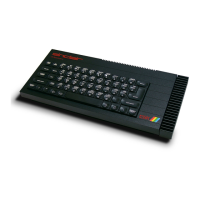1 is the shortest note and 9 the longest. They are related to musical convention according to the following table.
Each of these controls the length of all notes which follow it until you give a new number code.
You can also use the numbers from 10 to 12 to specify triplet notes (three notes played in the time normally used for
two).
Each of these only applies to the three notes following it and must be followed by their three names, eg
10 LET a$="11ACE"
A rest (no note playing) is specified by a & and has the same length as the current note. For example
10 LET a$="7A&B&C&D&E"
is five minims with equal pauses between them.
Tied notes can be indicated by giving the two note durations connected by an underscore character and the note
name, eg
10 LET a$="3_5A"
The second note duration you give will also apply to any following codes until you give another duration code.
Note volume
The overall volume of the sound is controlled by the volume setting of your TV or amplifier. You can control the
volume of individual notes and phrases within the tune by using the V command. V followed by a number from 0 to 15
sets the following note(s) to a constant volume. The lower the number, the quieter the sound, with V0 completely silent
(V0 is a useful way of stopping one channel playing while others continue). V15 is the maximum and is used
automatically by the Spectrum 128 if you do not specify a level.
The low volumes are very quiet and you will normally use 10 to 15 unless you are outputting to an amplification system
or via the MIDI port to a synthesizer. Try running this program
10 LET a$="V10cdefgabCDEFGAB"
20 PLAY a$
Now try changing the number after the V to a new value to hear the difference
Volume effects
Instead of you just setting each note to a fixed volume, PLAY also lets you change the volume of the sound while it is
playing. For example, you can make a note start suddenly and then die away (like a piano) or make a sound effect rise
and fall in volume (like a steam train).
This effect is controlled by the letter W which can be included in any of the strings controlled by the PLAY command.
You must also include the letter U in each string where you want to use the effect. You cannot use it if the string
already has a volume setting (if it contains a V) - the volume command will overrule the effect.
Number Note Name Musical symbol
1 semi quaver
2 dotted semi-quaver
3 quaver
4 dotted quaver
5 crotchet
6 dotted crotchet
7 minim
8 dotted minim
9 semi-breve
Number Note Name Musical symbol
10 triplet semi-quaver
11 triplet quaver
12 triplet crotchet
The N Command
In some or the examples you will see the
letter N used to introduce a series of
notes within the string, eg
LET a$="O7N1CDE"
N is used in cases where two sets of
numbers would otherwise clash. In the
example above, 0 is set to octave 7, then
a series of notes is given, starting with
the duration code 1.
Without the N code, the Spectrum 128
would read the octave code as 71 -
obviously not what was intended!
Please purchase VeryPDF HTML Converter on http://www.verypdf.com to remove this watermark.
Please purchase VeryPDF HTML Converter on http://www.verypdf.com to remove this watermark.
Please purchase VeryPDF HTML Converter on http://www.verypdf.com to remove this watermark.
Please purchase VeryPDF HTML Converter on http://www.verypdf.com to remove this watermark.
Please purchase VeryPDF HTML Converter on http://www.verypdf.com to remove this watermark.
Please purchase VeryPDF HTML Converter on http://www.verypdf.com to remove this watermark.
Please purchase VeryPDF HTML Converter on http://www.verypdf.com to remove this watermark.
Please purchase VeryPDF HTML Converter on http://www.verypdf.com to remove this watermark.
Please purchase VeryPDF HTML Converter on http://www.verypdf.com to remove this watermark.
Please purchase VeryPDF HTML Converter on http://www.verypdf.com to remove this watermark.

